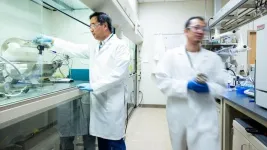(Press-News.org) A plentiful supply of clean energy is lurking in plain sight. It is the hydrogen we can extract from water (H2O) using renewable energy. Scientists are seeking low-cost methods for producing clean hydrogen from water to replace fossil fuels, as part of the quest to combat climate change.
Hydrogen can power vehicles while emitting nothing but water. Hydrogen is also an important chemical for many industrial processes, most notably in steel making and ammonia production. Using cleaner hydrogen is highly desirable in those industries.
“By using the cobalt-based catalyst prepared by our method, one could remove the main bottleneck of cost to producing clean hydrogen in an electrolyzer.” — Di-Jia Liu, senior chemist at Argonne
A multi-institutional team led by the U.S. Department of Energy’s (DOE) Argonne National Laboratory has developed a low-cost catalyst for a process that yields clean hydrogen from water. Other contributors include DOE’s Sandia National Laboratories and Lawrence Berkeley National Laboratory, as well as Giner Inc.
“A process called electrolysis produces hydrogen and oxygen from water and has been around for more than a century,” said Di-Jia Liu, senior chemist at Argonne. He also holds a joint appointment in the Pritzker School of Molecular Engineering at the University of Chicago.
Proton exchange membrane (PEM) electrolyzers represent a new generation of technology for this process. They can split water into hydrogen and oxygen with higher efficiency at near room temperature. The reduced energy demand makes them an ideal choice for producing clean hydrogen by using renewable but intermittent sources, such as solar and wind.
This electrolyzer runs with separate catalysts for each of its electrodes (cathode and anode). The cathode catalyst yields hydrogen, while the anode catalyst forms oxygen. A problem is that the anode catalyst uses iridium, which has a current market price of around $5,000 per ounce. The lack of supply and high cost of iridium pose a major barrier for widespread adoption of PEM electrolyzers.
The main ingredient in the new catalyst is cobalt, which is substantially cheaper than iridium. “We sought to develop a low-cost anode catalyst in a PEM electrolyzer that generates hydrogen at high throughput while consuming minimal energy,” Liu said. “By using the cobalt-based catalyst prepared by our method, one could remove the main bottleneck of cost to producing clean hydrogen in an electrolyzer.”
Giner Inc., a leading research and development company working toward commercialization of electrolyzers and fuel cells, evaluated the new catalyst using its PEM electrolyzer test stations under industrial operating conditions. The performance and durability far exceeded that of competitors’ catalysts.
Important to further advancing the catalyst performance is understanding the reaction mechanism at the atomic scale under electrolyzer operating conditions. The team deciphered critical structural changes that occur in the catalyst under operating conditions by using X-ray analyses at the Advanced Photon Source (APS) at Argonne. They also identified key catalyst features using electron microscopy at Sandia Labs and at Argonne’s Center for Nanoscale Materials (CNM). The APS and CNM are both DOE Office of Science user facilities.
“We imaged the atomic structure on the surface of the new catalyst at various stages of preparation,” said Jianguo Wen, an Argonne materials scientist.
In addition, computational modeling at Berkeley Lab revealed important insights into the catalyst’s durability under reaction conditions.
The team’s achievement is a step forward in DOE’s Hydrogen Energy Earthshot initiative, which mimics the U.S. space program’s “Moon Shot” of the 1960s. Its ambitious goal is to lower the cost for green hydrogen production to one dollar per kilogram in a decade. Production of green hydrogen at that cost could reshape the nation’s economy. Applications include the electric grid, manufacturing, transportation and residential and commercial heating.
“More generally, our results establish a promising path forward in replacing catalysts made from expensive precious metals with elements that are much less expensive and more abundant,” Liu noted.
This research was published on May 12 in Science and was supported by the DOE Office of Energy Efficiency and Renewable Energy, Hydrogen and Fuel Cell Technologies Office, as well as by Argonne Laboratory Directed Research and Development funding.
In addition to Liu, Argonne authors are Lina Chong (now at Shanghai Jiao Tong University), Jianguo Wen, Haiping Xu, A. Jeremy Kropf, Wenqian Xu and Xiao-Min Lin. Authors from Berkeley Lab include Guoping Gao, Haixia Li and Ling-Wang Wang. The author from Sandia Labs is Joshua D. Sugar. Contributors Zach Green and Hui Xu are from Giner Inc.
About Argonne’s Center for Nanoscale Materials
The Center for Nanoscale Materials is one of the five DOE Nanoscale Science Research Centers, premier national user facilities for interdisciplinary research at the nanoscale supported by the DOE Office of Science. Together the NSRCs comprise a suite of complementary facilities that provide researchers with state-of-the-art capabilities to fabricate, process, characterize and model nanoscale materials, and constitute the largest infrastructure investment of the National Nanotechnology Initiative. The NSRCs are located at DOE’s Argonne, Brookhaven, Lawrence Berkeley, Oak Ridge, Sandia and Los Alamos National Laboratories. For more information about the DOE NSRCs, please visit https://science.osti.gov/User-Facilities/User-Facilities-at-a-Glance.
About the Advanced Photon Source
The U. S. Department of Energy Office of Science’s Advanced Photon Source (APS) at Argonne National Laboratory is one of the world’s most productive X-ray light source facilities. The APS provides high-brightness X-ray beams to a diverse community of researchers in materials science, chemistry, condensed matter physics, the life and environmental sciences, and applied research. These X-rays are ideally suited for explorations of materials and biological structures; elemental distribution; chemical, magnetic, electronic states; and a wide range of technologically important engineering systems from batteries to fuel injector sprays, all of which are the foundations of our nation’s economic, technological, and physical well-being. Each year, more than 5,000 researchers use the APS to produce over 2,000 publications detailing impactful discoveries, and solve more vital biological protein structures than users of any other X-ray light source research facility. APS scientists and engineers innovate technology that is at the heart of advancing accelerator and light-source operations. This includes the insertion devices that produce extreme-brightness X-rays prized by researchers, lenses that focus the X-rays down to a few nanometers, instrumentation that maximizes the way the X-rays interact with samples being studied, and software that gathers and manages the massive quantity of data resulting from discovery research at the APS.
This research used resources of the Advanced Photon Source, a U.S. DOE Office of Science User Facility operated for the DOE Office of Science by Argonne National Laboratory under Contract No. DE-AC02-06CH11357.
Argonne National Laboratory seeks solutions to pressing national problems in science and technology. The nation’s first national laboratory, Argonne conducts leading-edge basic and applied scientific research in virtually every scientific discipline. Argonne researchers work closely with researchers from hundreds of companies, universities, and federal, state and municipal agencies to help them solve their specific problems, advance America’s scientific leadership and prepare the nation for a better future. With employees from more than 60 nations, Argonne is managed by UChicago Argonne, LLC for the U.S. Department of Energy’s Office of Science.
The U.S. Department of Energy’s Office of Science is the single largest supporter of basic research in the physical sciences in the United States and is working to address some of the most pressing challenges of our time. For more information, visit https://energy.gov/science.
END
Extracting a clean fuel from water
New catalyst lowers cost for producing environmentally sustainable hydrogen from water
2023-05-30
ELSE PRESS RELEASES FROM THIS DATE:
NJIT researchers awarded $4.6m to unlock mysteries of solar eruptions
2023-05-30
A New Jersey Institute of Technology research team led by physics professor Wenda Cao at the university’s Center for Solar Terrestrial Research (CSTR) has been awarded a $4.64 million National Science Foundation grant to continue leading explorations of the Sun’s explosive activity at Big Bear Solar Observatory (BBSO).
The grant marks the largest project that the Solar-Terrestrial Research Program under NSF’s Division of Atmospheric and Geospace Sciences (AGS) supports, extending five more years of baseline funding for all science, instrumentation and education activities at BBSO, located at California’s Big Bear Lake.
The ...
Extended lymph node removal does not benefit patients with clinically localized muscle-invasive bladder cancer
2023-05-30
An extended lymphadenectomy – removal of additional lymph nodes beyond the extent of the standard procedure – in patients undergoing radical cystectomy (removal of bladder and nearby tissues) because of clinically localized muscle-invasive bladder cancer provides no patient benefit as measured by disease-free survival or overall survival times. It does, however, increase the risk of adverse events (side effects) and post-surgical death.
These primary results from the phase 3 SWOG S1011 clinical ...
Study finds sex education tool improves reproductive health knowledge among adolescent girls
2023-05-30
HUNTINGTON, W.Va. – A Marshall University study found that a virtual sex education tool improved reproductive health knowledge scores and measures of self-efficacy among adolescent girls.
The findings, published last month in Sex Education, a leading international journal on sex, sexuality and relationships in education, found that sexual health knowledge scores on a validated scale increased among participants, along with improved measures of self-efficacy regarding birth control, healthy relationships and sexually transmitted infection (STI) prevention. Notably, ...
No-till revolution could stop Midwest topsoil loss in its tracks
2023-05-30
American Geophysical Union
25 May 2023
AGU Release No. 22
For Immediate Release
This press release and accompanying multimedia are available online at: https://news.agu.org/press-release/no-till-revolution-could-stop-midwest-topsoil-loss-in-its-tracks/
No-till revolution could stop Midwest topsoil loss in its tracks
If Midwestern farms all adopted low-intensity tilling practices or stopped tilling entirely, the erosion of critical topsoil could decrease by 95% in the next 100 years, new study finds
AGU press contact:
Rebecca ...
Computational method uncovers the effects of mutations in the noncoding genome
2023-05-30
Less than two percent of the human genome codes for proteins, with the rest being noncoding and likely helping with gene regulation. Mutations in the noncoding genome often trigger trait changes that cause disease or disability by altering gene expression. However, it can be hard for scientists to track down which of numerous variants associated with a disease or other complex trait are the causal ones and to understand the mechanism of their effects. Researchers at the Brigham developed a new computational approach that hones in on small regions of the noncoding genome that genome-wide association studies (GWAS) identified ...
Extreme precipitation in northeast to increase 52% by the end of the century
2023-05-30
With a warmer climate creating more humid conditions in the Northeast, extreme precipitation events — defined as about 1.5 or more inches of heavy rainfall or melted snowfall in a day — are projected to increase in the Northeast by 52% by the end of the century, according to a new Dartmouth study.
The findings are published in Climatic Change.
"As climate change brings warmer temperatures, you have more water vapor in the atmosphere, which creates the right conditions for extreme precipitation," says first author Christopher J. Picard '23, an earth sciences major and undergraduate researcher in the Applied Hydroclimatology Group ...
Lung infection may be less transmissible than thought
2023-05-30
A little-known bacterium — a distant cousin of the microbes that cause tuberculosis and leprosy — is emerging as a public health threat capable of causing severe lung infections among vulnerable populations, those with compromised immunity or reduced lung function.
Recent research found that various strains of the bacterium, Mycobacterium abscessus, were genetically similar, stoking fears that it was spreading from person to person.
But a new study by Harvard Medical School researchers published ...
Experimental decoy protects against SARS-CoV-2 infection
2023-05-30
An experimental “decoy” provided long-term protection from infection by the pandemic virus in mice, a new study finds.
Led by researchers at NYU Grossman School of Medicine, the work is based on how the virus that causes COVID-19, SARS-CoV-2, uses its spike protein to attach to a protein on the surface of the cells that line human lungs. Once attached to this cell surface protein, called angiotensin converting enzyme 2 (ACE2), the virus spike pulls the cell close, enabling the virus to enter the cell and hijack its machinery to make viral copies.
Earlier in the pandemic, pharmaceutical ...
Light conveyed by the signal transmitting molecule sucrose controls growth of plant roots
2023-05-30
Plant growth is driven by light and supplied with energy through photosynthesis by green leaves. It is the same for roots that grow in the dark – they receive the products of photosynthesis, in particular sucrose, i.e. sugar, via the central transportation pathways of phloem. Dr. Stefan Kircher and Prof. Dr. Peter Schopfer from the University of Freiburg’s Faculty of Biology have now shown in experiments using the model plant Arabidopsis thaliana (thale cress) that the sucrose not only guarantees the supply of carbohydrates to the roots, it also acts as a signal transmitter for ...
Mitigating climate change through restoration of coastal ecosystems
2023-05-30
One of the primary drivers of climate change is excess greenhouse gases like carbon dioxide in the atmosphere. Mitigating climate change in the coming century will require both decarbonization — electrifying the power grid or reducing fossil fuel-guzzling transportation — and removing already existing carbon dioxide from the atmosphere, a process called carbon dioxide removal.
Researchers at the Georgia Institute of Technology and Yale University are proposing a novel pathway through which coastal ecosystem restoration can permanently capture carbon dioxide from the atmosphere. Seagrass and mangroves — known as blue carbon ecosystems — naturally capture ...
LAST 30 PRESS RELEASES:
New expert guidance urges caution before surgery for patients with treatment-resistant constipation
Solar hydrogen can now be produced efficiently without the scarce metal platinum
Sleeping in on weekends may help boost teens’ mental health
Study: Teens use cellphones for an hour a day at school
After more than two years of war, Palestinian children are hungry, denied education and “like the living dead”
The untold story of life with Prader-Willi syndrome - according to the siblings who live it
How the parasite that ‘gave up sex’ found more hosts – and why its victory won’t last
When is it time to jump? The boiling frog problem of AI use in physics education
Twitter data reveals partisan divide in understanding why pollen season's getting worse
AI is quick but risky for updating old software
Revolutionizing biosecurity: new multi-omics framework to transform invasive species management
From ancient herb to modern medicine: new review unveils the multi-targeted healing potential of Borago officinalis
Building a global scientific community: Biological Diversity Journal announces dual recruitment of Editorial Board and Youth Editorial Board members
Microbes that break down antibiotics help protect ecosystems under drug pollution
Smart biochar that remembers pollutants offers a new way to clean water and recycle biomass
Rice genes matter more than domestication in shaping plant microbiomes
Ticking time bomb: Some farmers report as many as 70 tick encounters over a 6-month period
Turning garden and crop waste into plastics
Scientists discover ‘platypus galaxies’ in the early universe
Seeing thyroid cancer in a new light: when AI meets label-free imaging in the operating room
Neutrophil-to-lymphocyte ratio may aid risk stratification in depressive disorder
2026 Seismological Society of America Annual Meeting
AI-powered ECG analysis offers promising path for early detection of chronic obstructive pulmonary disease, says Mount Sinai researchers
GIMM uncovers flaws in lab-grown heart cells and paves the way for improved treatments
Cracking the evolutionary code of sleep
Medications could help the aging brain cope with surgery, memory impairment
Back pain linked to worse sleep years later in men over 65, according to study
CDC urges ‘shared decision-making’ on some childhood vaccines; many unclear about what that means
New research finds that an ‘equal treatment’ approach to economic opportunity advertising can backfire
Researchers create shape-shifting, self-navigating microparticles
[Press-News.org] Extracting a clean fuel from waterNew catalyst lowers cost for producing environmentally sustainable hydrogen from water


